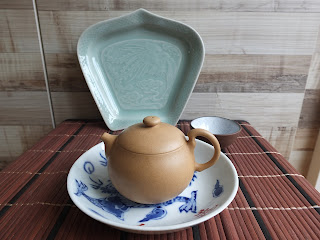This is the time of the year where mooncakes are available for sale In Chinese confectionary and grocery shops. These cakes are made and eaten to celebrate the Chinese mid autumn festival (next week). If you had not tried mooncakes, they are actually baked pastries filled with sweetened lotus or bean paste. Some of these cakes may include a salted duck yolk inside. Somehow, this unusual combination makes eating a mooncake a pleasure to eat. I love mooncakes. My daughter managed to snagged a box for me at the Hong Kong Airport while she was there last week. Yummy.
Mooncakes and Chinese tea makes a great pairing. The sweetness of the mooncake and sipping Chinese tea makes for an addictive exercise. I can gobble half a mooncake in one sitting. I feel pu erh tea and high roasted oolong are good with mooncakes.
I had received a couple of questions on how I would store my pu erh when I had broken up a cake or tuo. I would break up the tea cake into small pieces and store them in one of the tea caddies you see the in pix. The rice porcelain piece is actually a double-boil soup vessel where traditional Chinese soups were prepared in the container and the whole container is half immersed in a large pot of boiling water and cooked for a few hours. You will notice that this rice porcelain container is double lidded and I am using it as a pu erh tea caddy. These porcelain containers are easily available in Chinatown in your neighbourhood. They were inexpensive when I saw them in San Francisco and Toronto Chinese shops during my last visit.
I would placed the broken pu erh pieces inside and fold the erh wrapper on top of the tea (so I can identify the tea if I had forgotten about the contents). I will put this tea caddy inside my tea cupboard and only taking it out when I want to brew the tea. Yes, this container is not airtight, which allows to tea pieces inside to breathe (Chinese call this Xin Cha). This allows the pu erh to 'awake' and I personally find that the tea tasted better if allowed to breathe for at least 2 weeks after breaking up your pu erh.
In addition, the paper boxed tea caddy and the used oolong tin, in the above pix, are also equally good, in my opinion to store your pu erh tea. I am using 8 tea caddies for my pu erh (5 raw and 3 ripe).
How do you store your pu erh tea for daily drinking?











